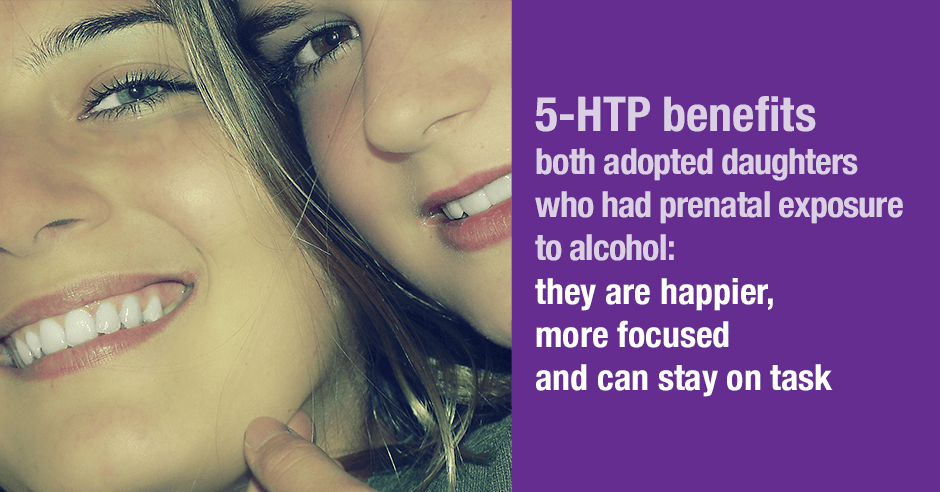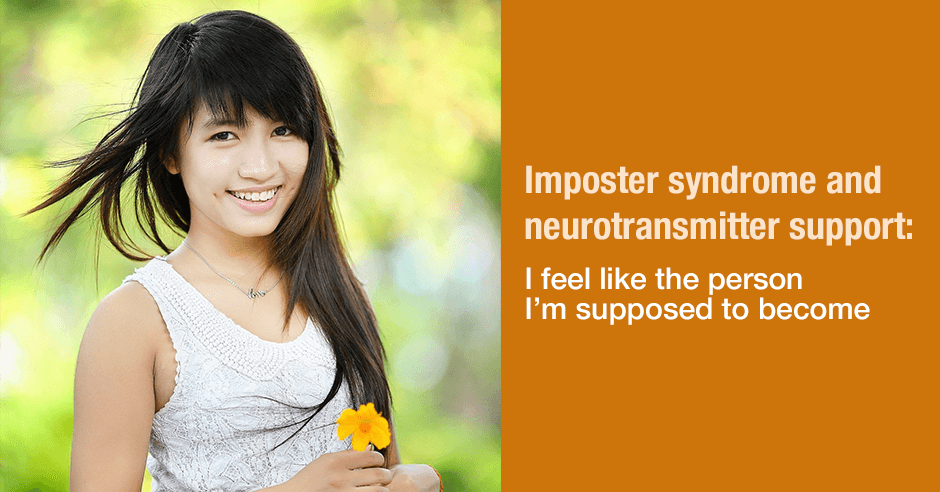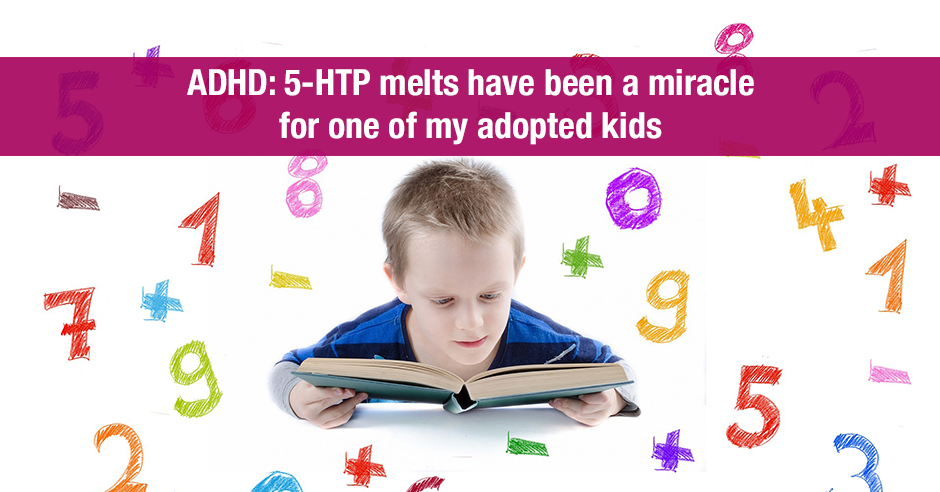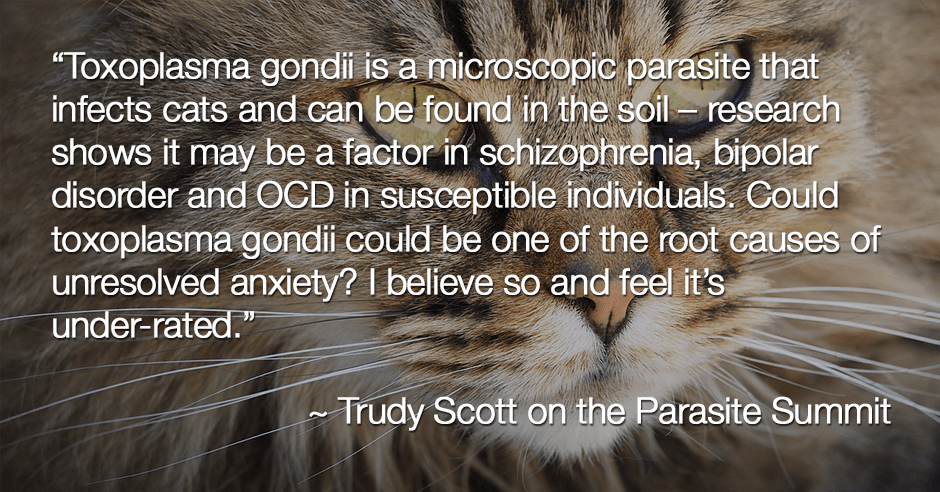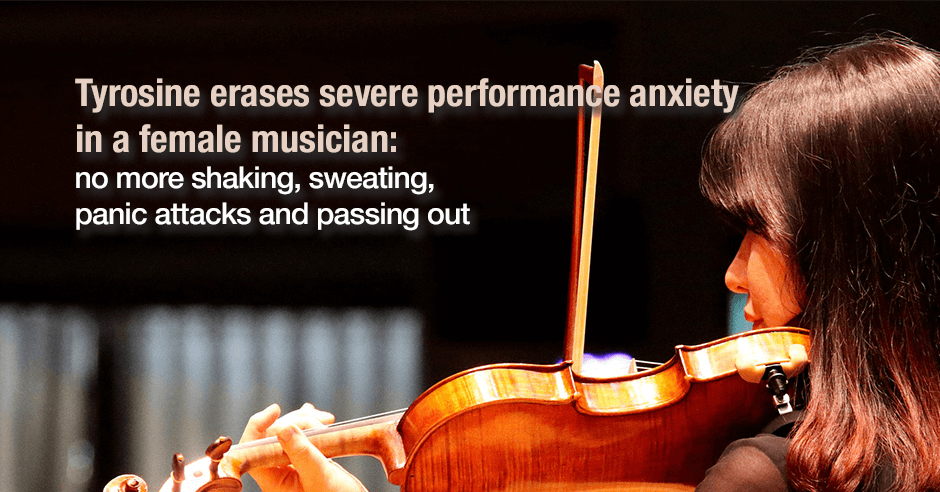
Today I’m sharing the case of a female musician with severe performance anxiety. It was so severe that she would shake, sweat and actually pass out. She also had problems breathing which happens when you’re having a panic attack. Surprisingly, the amino acid supplement tyrosine eliminates – or as she says, erases – all these anxiety symptoms very quickly. It’s surprising because tyrosine is typically not used for easing anxiety symptoms and is instead used to support the low catecholamine symptoms: low motivation, low energy, poor focus, feeling flat and depressed (the curl-up-in-bed kind), cravings for sugary foods for better energy and the need for caffeine.
I share her story in her own words and explore some possible mechanisms around serotonin, cortisol, dopamine and GABA.
Pam initially shared on a Facebook thread how tyrosine erased her extreme performance anxiety and we dug deeper. This is the start of the conversation:
I’ve been performing (music) ever since I was seven, but I always hated it. For extreme performance anxiety, I found, way too late, that 1,500mg of l-tyrosine simply erased the shaking and fainting, and I was “just nervous like everybody else.”
I responded saying what a great result this was and shared that I found it so interesting that tyrosine erased the shaking and fainting that she experienced with her performance anxiety.
As I mentioned above, tyrosine is typically not used for anxiety. Instead, it’s used to improve the low catecholamine symptoms of poor focus, low energy and low motivation. (More on this here)
I also always want to understand the mechanism as to why an amino acid helps ease anxiety symptoms – or in this case erased them. I share more on that below.
When I asked what she meant by “just nervous like everybody else“, this was her response:
It means pretty much everyone gets performance nerves, but not to the point of fainting on stage. Knowing intellectually that that was ridiculous did not make any difference in the fact that it occurred.
I don’t even remember why I tried tyrosine, but I do remember the first time I took it 40 minutes before a performance. I waltzed out on stage ahead of time and sat in my chair warming up, showing off even, to a hall that was filling with people.
That was and is inconceivable without the tyrosine support, which I have to assume is putting my dopamine at a normal level. Yes, I get a little wired, which can be a good thing, but passing out, having my intestines demand to be emptied, not being able to breathe [is this a panic attack?], shaking, sweating….it fixes all of that.
It’s wonderful to hear such powerful results from 1,500mg tyrosine and how quickly it works. The latter is not surprising as this is typical with all the amino acids. They work quickly if it’s what you need and you have the ideal dose for your needs.
What is surprising is that tyrosine erased her severe performance anxiety symptoms. I immediately started trying to understand possible mechanisms.
What is the mechanism – a serotonin boost to improve confidence?
When I read “I waltzed out on stage ahead of time and sat in my chair warming up, showing off even, to a hall that was filling with people” I immediately thought of how tryptophan or 5-HTP works to give you a serotonin boost that improves your confidence.
However, Pam doesn’t feel the mechanism is related to low serotonin:
You would think, if it were serotonin, that SSRIs would be effective. They are not and cause me to have terror attacks.
She also shared that she recently gave 5-HTP a trial and it did nothing so that further supports her theory/gut feeling that her extreme performance anxiety is not related to low serotonin:
I think there is a belief system associated with serotonin that is not cognizant of the fact that the other neurotransmitters can be the culprits. I read someone’s web site sometime not that long ago, that detailed how to test all the major neurotransmitters, find out which ones were to low OR too high, and what amino acids to take to fix the imbalances. To me, this is a more comprehensive view than being stuck on serotonin.
Anxiety is not always caused by low serotonin or low GABA (although these causes are very common). I’m with Pam on finding which neurotransmitter imbalance you have. There is no one-size fits all and results can happen without us fully understanding why. It does sound like this is very much dopamine related for her but I wanted to understand how it was helping her.
What is the mechanism – lowering cortisol under extremely stressful situations?
I started looking into the research and found that one possible mechanism could be that tyrosine lowers the high cortisol that occurs after an extremely stressful situation – like going on stage to perform – and eases anxiety this way.
An animal study supports this theory: Dietary tyrosine suppresses the rise in plasma corticosterone following acute stress in rats:
Acute, uncontrollable stress increases norepinephrine (NE) turnover in the rat’s brain (depleting NE) and diminishes the animal’s subsequent tendency to explore a novel environment. Pre-treatment with tyrosine can reverse these adverse effects of stress, presumably by preventing the depletion of NE in the hypothalamus.
In the present study, we found that pre-treatment with supplemental tyrosine not only prevented the behavioral depression and hypothalamic NE depletion observed after an acute stress, but also suppressed the rise in plasma corticosterone. These results support a role for brain NE in stress-induced corticosterone secretion and demonstrate that supplemental tyrosine can protect against several adverse consequences of such stress.
Keep in mind that cortisol is the primary endogenous adrenal steroid in humans, whereas corticosterone is the primary adrenal corticosteroid in laboratory rats.
What is the mechanism – dopaminergic system influence on anxiety-like behavior?
I dug deeper into the research and found that there is evidence that dopamine plays an important role in anxiety modulation in different parts of the brain and that both dopamine D1 and D2 receptor mechanisms are important in mediating anxiety.
This paper, The Modulatory Role of Dopamine in Anxiety-like Behavior describes some of this, together with the role of GABA and glutamate:
The activity of dopaminergic system is modulated by several neurotransmitters, including glutamatergic neurons from the medial prefrontal cortex (mPFC), GABAergic fibers from the nucleus accumbens (NAc) as well as the ventral pallidum and cholinergic fibers from the pedunculopontine nucleus and the laterodorsal tegmental nucleus. Thus, changes in the glutamatergic, and GABAergic, as well as mediated transmission in the mesolimbic, mesocortical and nigrostriatal dopaminergic system may influence anxiety-like behavior.
In the past I’ve blogged about tyrosine for alleviating anxiety and panic attacks and creating a feeling of calm focus so this is not an isolated case but it is pretty unusual. As I share in the above blog, a man and a woman saw dramatic reductions in their anxiety when using tyrosine. GABA and tryptophan had not helped and both individuals were also under extreme stress. It was work stress in their cases and both of them felt that their ability to now focus in business situations eased their severe anxiety.
Regardless of the mechanism, Pam saw profound results and that is all that really matters.
My additional feedback on dosing and timing
Here is some additional feedback from me on dosing and timing. On one hand I recommend caution based on my experience with the amino acids. And on the other hand, what she did worked so I’m torn about her approach but am going to say it anyway:
- A typical starting dose is 500mg tyrosine and I would never have anyone start with 1,500mg (even though it was the sweet spot for Pam). However, if she hadn’t used that dose, she would not have had the same results. I’m waiting to hear back if she started with 1,500mg tyrosine or worked up to this. (Pam also told a friend of hers about her results and the outcome was very different for her friend:“She tried 100mg of tyrosine and it caused her extreme nervousness, the opposite of me. I have to assume that 100mg put her at too *much* dopamine, and her genetic profile was significantly different from mine.” We are all unique and there is no one-size-fits-all.)
- I would also be cautious about trying a new amino acid for the first time right before a major event like a musical performance. I have clients trial the amino acids at home before heading out. However, if she had done that she would likely have not experienced the desired results.
I feel it would be helpful to know if she had done a trial of GABA or tryptophan before using tyrosine but it seems she doesn’t recall this or why she decided to use 1,500mg tyrosine. If she hasn’t done I trial with both GABA and tryptophan, I would love her to consider this now in order to potentially take things up a notch further and ease her feelings of just being “nervous like everybody else”.
I appreciate Pam sharing her amazing results with tyrosine and I’m really happy for her! I’m waiting to hear back with details of what kind of musical performances she does. I’ll share this and the other information once I hear back.
I say it often and I’ll say it again – there is not a one-size-fits-all. This case illustrates this very well. Sometimes it’s methodical trial and error (my preference) and other times it’s hit and miss when nothing else seems to be helping.
Resources if you are new to using tyrosine as a supplement
If you are new to using the amino acid tyrosine as a supplement, here is the Amino Acids Mood Questionnaire from The Antianxiety Food Solution and a brief overview here, Anxiety and targeted individual amino acid supplements: a summary.
If you suspect low levels of any of the neurotransmitters and do not yet have my book, The Antianxiety Food Solution – How the Foods You Eat Can Help You Calm Your Anxious Mind, Improve Your Mood, and End Cravings, I highly recommend getting it and reading it before jumping in and using amino acids so you are knowledgeable.
The book doesn’t include product names (per the publisher’s request) so this blog, The Antianxiety Food Solution Amino Acid and Pyroluria Supplements, lists tyrosine and other products that I use with my individual clients and those in my group programs.
As with all individual amino acids we use tyrosine for quick relief of symptoms, like Pam did. And we must also always focus on the foundations like diet, the gut, adrenals and stress levels.
Do you use or have you used tyrosine to help with performance anxiety – personally or with a patient/client?
And were you/are you surprised that this worked so well when tryptophan or 5-HTP or GABA had not worked as expected?
What other symptoms did/does the tyrosine help improve: focus, motivation, drive, low energy, low mood? And did/does it help reduce sugar cravings and the need for caffeine?
Feel free to post your questions here too.
